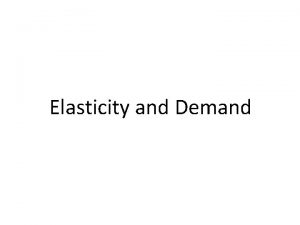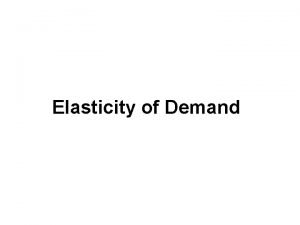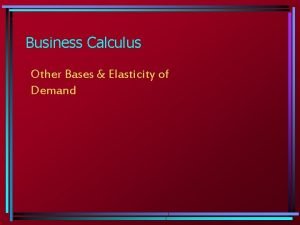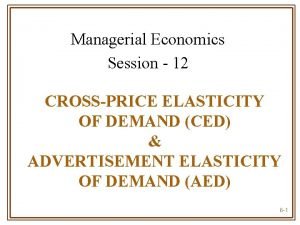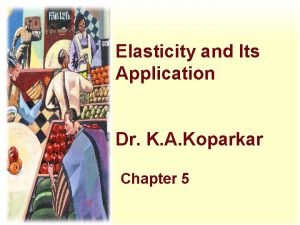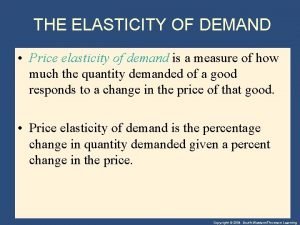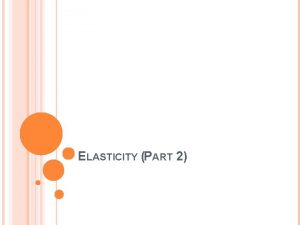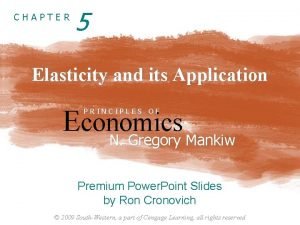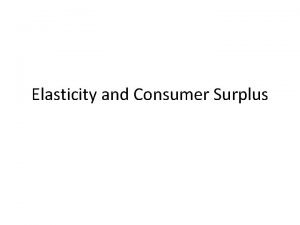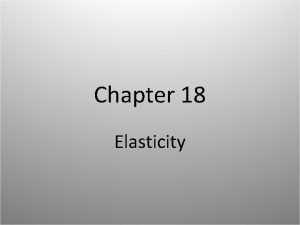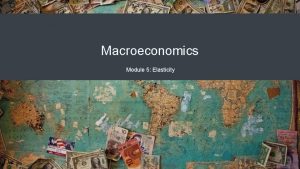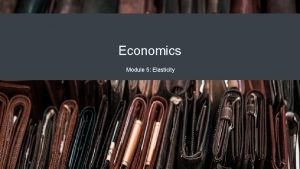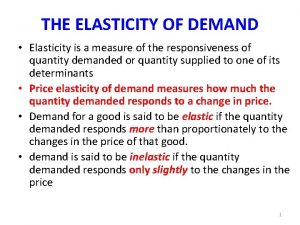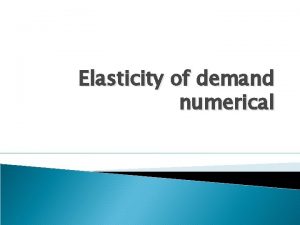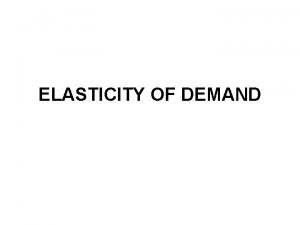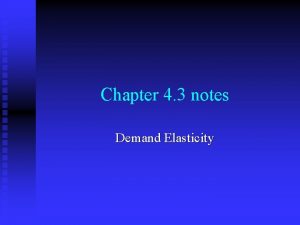Elasticity of Demand Elasticity is a measure of












- Slides: 12

Elasticity of Demand

Elasticity. . . … is a measure of how much buyers and sellers respond to changes in market conditions u … allows us to analyze supply and demand with greater precision. u. Journal Question-Name 3 necessities and 3 luxuries that you would buy. u

Price Elasticity of Demand u Price elasticity of demand is the percentage change in quantity demanded given a percent change in the price. u It is a measure of how much the quantity demanded of a good responds to a change in the price of that good.

Elasticity, Percentage Change and Slope Because the price elasticity of demand measures how much quantity demanded responds to the price, it is closely related to the slope of the demand curve. But instead of looking at unit change, elasticity looks at percentage change. What do we mean by percentage change?

Brief Assessment on Percentages n n n If there are 50 tomatoes in a store and you picked 16 of them, what percentage of the total did you pick? Paul used to weigh 200 lbs last year, but now he only weighs 175 lbs. How many lbs did he lose? What is the percent change of the loss? What is the average of 300 and 330? What is the midpoint?

Ranges of Elasticity Inelastic Demand u Percentage change in price is greater than percentage change in quantity demand. u Price elasticity of demand is less than one. Elastic Demand u Percentage change in quantity demand is greater than percentage change in price. u Price elasticity of demand is greater than one.

Perfectly Inelastic Demand - Elasticity equals 0 Price Demand 1. An $5 increase in price. . . 4 Quantity 100 2. . leaves the quantity demanded unchanged.

Perfectly Elastic Demand - Elasticity equals infinity Price 1. At any price above $4, quantity demanded is zero. Demand $4 2. At exactly $4, consumers will buy any quantity. 3. At a price below $4, quantity demanded is infinite. Quantity

Determinants of Price Elasticity of Demand u Necessities versus Luxuries u Availability of Close Substitutes u Definition of the Market u Time Horizon

Determinants of Price Elasticity of Demand n Demand tends to be more inelastic äIf the good is a necessity. äIf the time period is shorter. äThe smaller the number of close substitutes. äThe more broadly defined the market.

Determinants of Price Elasticity of Demand tends to be more elastic : u if the good is a luxury. u the longer the time period. u the larger the number of close substitutes. u the more narrowly defined the market.

Income Elasticity - Types of Goods u Normal Goods u. Income Elasticity is positive. u Inferior Goods u. Income Elasticity is negative. u Higher income raises the quantity demanded for normal goods but lowers the quantity demanded for inferior goods.
 How to measure elasticity
How to measure elasticity The income elasticity of demand
The income elasticity of demand Arc elasticity formula
Arc elasticity formula Why is elasticity of demand negative
Why is elasticity of demand negative Elasticity calculator calculus
Elasticity calculator calculus Promotional elasticity of demand
Promotional elasticity of demand What are the 5 determinants of price elasticity of demand
What are the 5 determinants of price elasticity of demand Midpoint method price elasticity of demand
Midpoint method price elasticity of demand Measurements of elasticity of demand
Measurements of elasticity of demand Guided reading 4-3 elasticity of demand answers
Guided reading 4-3 elasticity of demand answers What are the 5 determinants of price elasticity of demand
What are the 5 determinants of price elasticity of demand Arc elasticity of demand
Arc elasticity of demand Cross price elasticity formula
Cross price elasticity formula

